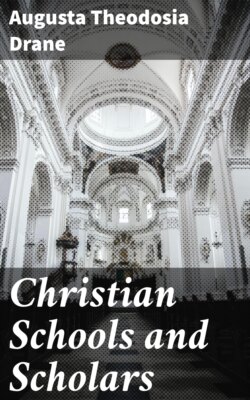Читать книгу Christian Schools and Scholars - Augusta Theodosia Drane - Страница 9
ОглавлениеOn the death of Egbert in 766 the unanimous voice of the people called Albert to the vacant see. He showed himself worthy of their choice, “feeding his flock with the food of the Divine Word, and guarding the lambs of Christ from the wolf.” He governed the Church of York for thirteen years, during which time he never abandoned his care of the school. The mastership, however, devolved on Alcuin, and such was the fame of his scholarship as to draw students not only from all parts of England and Ireland, but also from France and Germany. Among the latter was St. Luidger, a native of Friesland, afterwards known as the Apostle of Saxony, of whom we shall have more to say in the following chapter.
The extent and character of Alcuin’s learning will be more properly studied when we come to speak of his labours at the court of Charlemagne; it will be sufficient here to notice the fact that he was a scholar of exclusively English growth, and drew all the materials with which he worked in his after career from the library and the schools of York. In his writings he often alludes to the want he feels of “those invaluable books of scholastic erudition” which were there placed at his command, through the affectionate industry of his master, Albert, who continued, after his elevation to the episcopate, to add to the treasures already collected. Two years before his death Albert resolved on resigning his pastoral charge that he might spend his last days as a simple monk, and devote himself exclusively to the affairs of his salvation. Calling to him, therefore, his two favourite pupils, Eanbald and Alcuin, he committed to the first the care of his diocese, and to the other that of his books, “the dearest of all his treasures.”[61] Alcuin was despatched to Rome to obtain the sanction of the Holy See for the appointment of Eanbald and it was at Parma on his homeward journey that the solicitations of Charlemagne won his promise to settle at the court of that monarch, and transfer to a foreign soil the learning he had acquired on the shores of Saxon England.
With the death of Albert the prosperity of the Early English schools may be said to have closed. Five years later the Danish keels appeared for the first time off the Northumbrian coast: it seemed only a passing alarm, but in 793 another armament effected a landing at Lindisfarne, and after slaughtering the monks, gave to the flames the most venerable of the English sanctuaries. This was but the beginning of sorrows. The following year the twin monasteries of Wearmouth and Jarrow shared a similar fate, and all the treasures of art and literature collected by St. Biscop were ruthlessly destroyed. For seventy years these scenes of carnage and plunder went on without interruption in every part of England, and the riches laid up in the churches everywhere pointed them out as the first objects of attack. The finishing-blow came in 867, when “a great heathen army,” as they are called by the Saxon chronicler, having wintered in East Anglia, and there supplied themselves with horses, marched northwards and made themselves masters of the city of York. Thence they overran the kingdom of Northumbria, carrying fire and sword wherever they appeared, till the whole country between the Ouse and the Tyne presented only the smoking ruins of what had once been cities and abbeys. Beverley, Ripon, Whitby, and Lastingham, all seats of learning and civilisation, were swept away, and in 875 the sea-king Halden crossed the Tyne and destroyed the last remains of the monastic institute in Northumbria. After burning Jarrow for the second time, he directed his course to Lindisfarne, where the episcopal see was still fixed, and where a new monastery had sprung up on the ruins of that formerly destroyed by the Danes. Eardulf was then bishop, and on learning the approach of the pagans he determined to save the holy relics of St. Cuthbert by a timely flight. Calling his monks around him, therefore, he communicated to them his resolve, and having disinterred the body of the saint, together with those of St. Oswald and St. Aidan, they prepared to bid farewell to the holy island, whence the light of Christianity had shone forth over all the north of England for two hundred and forty years. This closing scene in the history of northern monasticism exhibits to us the monks of Lindisfarne in the hour of their sorest trial, surrounded by their school. There were in the monastery, says Simeon of Durham, a certain number of youths, brought up there from their infancy, who had been taught by the monks and trained in the singing of the Divine Office. These boys entreated Eardulf to suffer them to follow him. They set out, therefore, monks and children together, carrying the bier with the holy relics, their sacred vessels, the Holy Book of the Gospels, and their other books, and commenced that melancholy journey which, after seven years of wandering, was to bring them at last to the “grassy plain, on every side thickly wooded, but not easy to be made habitable,” where afterwards grew up, on the site of their wattled oratory, the princely city of Durham.
By these and similar calamities, extending not over one district, but over every part of the country, England was plunged back into the barbarism out of which she was but just emerging: her seats of learning were all swept away, and during the century that elapsed from the first landing of the Danes to the accession of Alfred, a night of gloomy darkness settled over the land.
